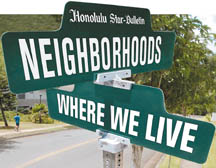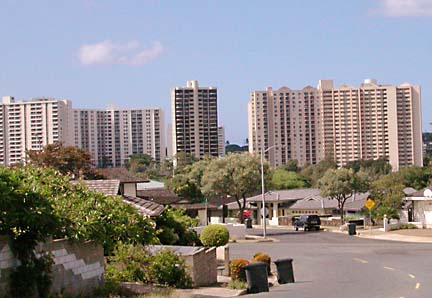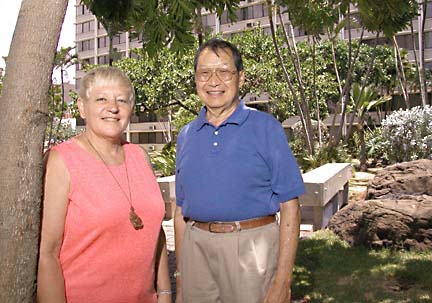
To feed a growing desire for housing in a land-scarce city, builders found the way to go was up.
Thus, high-rise structures sprouted in places like Salt Lake, where right-angled towers dwarf the geography from which the district takes its name. It is a commuter's haven -- close enough to make the drive downtown bearable, and girdled by the arteries of the H-1 and Moanalua freeways.
Downtown, most of the skyscrapers in Honolulu's business district house offices. But the landscape also is dotted with residential high-rises, founded in optimism that a thriving, lively downtown scene would replace the one now largely abandoned after sunset.
Salt Lake | Downtown
BACK TO TOP |
CRAIG T. KOJIMA / CKOJIMA@STARBULLETIN.COM
Salt Lake was developed about 40 years ago, attracting downtown Honolulu commuters with its mix of single-family homes and high-rise residential buildings.
Easy drive
attracted first buyers
The neighborhood known as Salt Lake was just a lake that rested quietly inside a crater not that many years ago.
Then, with statehood and the discovery of Hawaii by multitudes of visitors, tourism along with construction became the backbone of Hawaii's economy. Oahu's population grew and expanded outward from Honolulu.
The Salt Lake area, close to downtown, began to expand about 40 years ago with a mix of high-rise buildings and single-family homes. Moanalua High School opened in 1972 to serve the growing population.
Apartment and condo buildings line the makai side of the crater, while well-kept homes spread out mauka toward the backdrop provided by the side of Aliamanu Crater that separates the area from the freeway over Red Hill.
Much of the lake was filled in when the Honolulu Country Club was built in the late 1970s. The open water that remains separates the golf course from Salt Lake District Park Mauka, a city facility with playing fields and basketball and tennis courts.
"It's an affluent, upper middle-class neighborhood," said City Councilman Romy Cachola, who has lived there for 13 years. "There were standards to follow that the developers put in, and the residents take pride in their homes. There are about 30,000 people in the district, and it is a very convenient place to live. And the people out there are very friendly."
There also is Salt Lake District Park Makai with playing fields, a multipurpose building, gym and a new 50-meter pool that was dedicated last year.
"The biggest change over the years has been the completion of the parks," said Howard Shima, who moved into Salt Lake in 1968 and is a member of the neighborhood board. "There was not one foot of park space for the residents when we moved here."
Construction of the high-rises increased traffic, but the completion of the Tripler Interchange some 20 years ago alleviated that problem.
"The neighborhood board hasn't had to deal with any basic complaints or concerns recently other than the roundabouts the city is trying on a trial basis," said Shima. "The major concern is the rise in crime."
The Honolulu Police Department, in a draft report of crime in 2002, listed the Salt Lake District as having the highest number of auto thefts among Honolulu's nine police districts.
"The other serious concern is the Salt Lake waterway, which gets all the runoff water from the basin and doesn't have a way to free-flow to the ocean. It gets polluted, and we've had problems with the stench," said Shima, adding that Cachola is working with U.S. Rep. Neil Abercrombie (D-Hawaii) to get federal funding to fix it.
Other concerns of residents include the widening of Puuloa Road from Salt Lake Boulevard to Nimitz Highway -- scheduled for next year -- and the completion of the middle portion of Salt Lake Boulevard from Radford High School to the Salt Lake Shopping Center, Shima said.
Cachola does not foresee much more growth in the area. "It's pretty much built up," he said. "There are very few house lots left and practically none for condos."
BACK TO TOP |
CRAIG T. KOJIMA / CKOJIMA@STARBULLETIN.COM
Kukui Plaza residents Bill Yee and Dolores Mollring are among the involved owners who have helped make sure the state's largest condominium is well maintained.
Kukui Plaza is
a world in itself
Downtown's Kukui Plaza is a neighborhood unto itself. During the last quarter-century of its existence, this "mixed-use" condominium project has weathered economic highs and lows.
The building offers a microcosm of the history and life of downtown Honolulu's community of condominiums.
A vision of the Fasi mayoral administration of the 1970s, Kukui Plaza was grandly designed as a project to both revitalize the downtown business district and provide housing.
Years later, Kukui Plaza remains the largest condominium in the state. The large scale of this centrally located project includes two towers totaling 908 housing units, a commercial business mall, a 1,811-stall parking garage shared by residents and the public, and a well-maintained 2.6-acre park between the towers that has received the stamp of approval from the Outdoor Circle.
It is estimated that 6,000 people either live, work or pass through Kukui Plaza daily.
"I've seen major changes in this place over the years," said Delores Mollring, a resident owner since 1976 and neighborhood board member.
"The upkeep has been done very well, and the value of the condos has never gone down," she said. "It's its own little community."
Condo residents are a diverse mixture of longtime residents such as Mollring and Bill Yee (who also owns a business with his wife and sons in the project's mall and is a member of its board of directors), plus Asian immigrant families and single downtown-working professionals.
"There's also a lot of students from Hawaii Pacific University who live here," said Yee. "It's almost like a college dorm at times.
"The key to the project's success is good security. It provides a sense of well-being. I give the security people credit -- they take in their fair share of complaints about noise from the students, and they have to be very tolerant."
"But the college students are still an asset to the community," added Mollring, "because they help surrounding businesses remain profitable."
Kukui Plaza has gotten a major revamping over the last couple of years: a new coat of paint and a revitalized business mall.
"It's evolved into more of a little medical complex," said Yee.
Even the ever-present concerns about prostitution, drug dealing and the homeless are being met head-on by the weekly activity of the Downtown/Chinatown Citizens' Patrol.
"Most of the social services for these people are located here in downtown," said Mollring, "so it isn't something that will completely go away." But with the help of the citizens patrol, of which she is an active member, the problems can be managed.
"Downtown's safer than a lot of people think," Mollring said.





